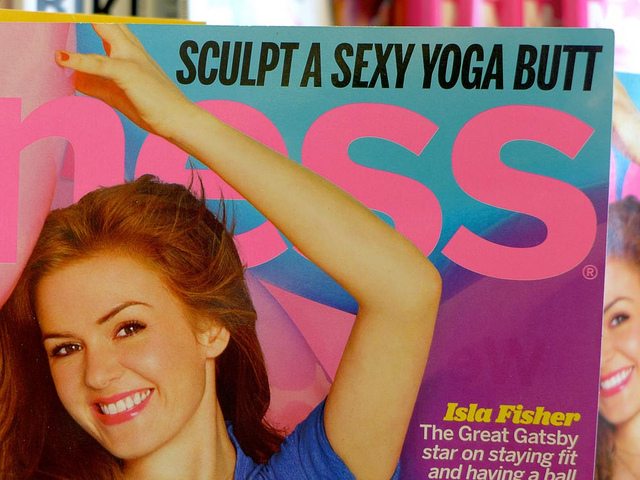
Last week I go to the curb to get the mail, and I’m idly leafing through it on the way back to the front door. It’s a huge stack. A lot of wasted paper to fill up my recycling bin. But, underneath it all, sandwiched safely between the Tuesday grocery coupons and a massive envelope containing tax worksheets from our accountant (*%&#$!) is my glossy, shiny, new yoga magazine. Its slick cover is practically pulsating with quippy bylines and the implied promise of serenity and a strong, healthy body.
The cover model is dressed adorably (Ooh…apparently, on page 76, I can win pants like hers!) and is sitting in a nice comfortable seated position (not lotus, which makes my post-surgical, torn meniscus cry out in sympathy for her future knee health), but in what my children’s teachers referred to as “Criss Cross, Applesauce.” Easy pose.
According to this month’s peppy cover, I am in store for a great measure of learning—how to get into those tricky arm balances; some short and simple sequences for my home practice; recipes for some mouthwatering, fresh and quick seasonal recipes; and the one that catches my eye, “Love Your Body: How to Silence Your Inner Critic.” I can’t wait to lie back in a bath with a glass of wine, and begin my journey to enlightened tranquility.
I go through the rest of my evening, dinner with husband and kids, dishes, general tidying, sign a last-minute permission slip, pay a couple of bills, get everyone settled in front of a television (and iPhones and two laptops) and steal away to my bathroom. Water running, steam rising, bubbles getting bigger, candle flickering, and my magazine resting on the edge of the tub.
I slip back into the bubbly water, making sure to keep my hands dry so as not to waterlog my new magazine. I reread the bylines and topics on the cover that I can look forward to inside, especially excited to learn how to “love my body and silence my inner critic,” and slowly, with the patience of the Dalai Lama, I turn to the first page.
The very first two pages of my magazine are a full layout photo of a yoga model. She is beautiful and is wearing the hippest yoga clothes I’ve ever seen, in vibrant blue tie-dye. Her hair is loose and wavy and, somehow, not getting in her eyes or mouth, even though she is inverted. She exudes calm; her body an instrument of strength; her face a picture of unflappable and placid composure. Her toenails are even painted a soft and perfect pink. She is in a pose that I can only describe as an “arm balance,” although that doesn’t begin to illustrate what she was doing. One leg is over her shoulder, straight and strong, and the other leg is over its corresponding shoulder, only it is bent at the knee and laying across her upper back. “You know, just relaxing, just casually throwing my leg over my upper back…” She is simply cool.
Right there, my self-confidence slides down a notch or two. “I will never come close to doing poses like that. My body just wasn’t built that way. And, God, her hair really does look awesome. My hair looks like sh*t when I’m practicing. And the veins in my forehead get really big and ugly. Why isn’t she sweaty? How does she look so cool?”
Trying to ignore the sudden chatter from my “inner critic,” I turn a couple of pages and stumble across an ad for these yoga sock things, which are little socks with sticky non-skid bumps on the soles so you can do yoga without a mat and without slipping. They’re like socks for babies so they can crawl and pull up on the edge of the sofa without wiping out. They are a brilliant idea, but even more brilliant is the company’s advertising campaign, which features a series of pictures of a nude yoga model in an incredibly strong and difficult arm balance, wearing nothing but, you guessed it, her special yoga socks.
At this point, I have yet to find the article on “loving my body and silencing my inner critic,” and even worse, my inner critic has awoken, and she is a mean girl! She’s telling me that I suck at yoga and talking smack to me. According to my inner critic, I have no business doing yoga. And, if I doubt her, all I have to do is look through the magazine and find tons of examples of people who clearly do have business doing yoga.
Countless specimens of smiling, beautiful contortionists; people practicing yoga on surfboards and paddleboards and craggy mountaintops; people practicing with partners (like Cirque du Soleil); and, in case I decide that simply practicing yoga and breathing and meditating when I can remember to isn’t enough, there are ads for gadgets and tools that will enhance my yoga life (such as a coconut hammer…I had no idea I needed a coconut hammer).
I feel overwhelmed and sad because I know that I will never achieve this level of yoga. Not the advanced level of poses, no matter how fully I devote myself to my practice. Not the look of the hip and breezy, cool yogi because no matter how many yoga clothes I buy, they all eventually look like tag sale rejects because I—get this—do yoga in them. I sweat; I roll around on the ground; I drip salsa on them; I get deodorant caked on them; I routinely cut huge holes in them when I tear out those blasted tags I wash them; I swim in them, and, yes, when I am forgetful, I dry them in a very hot dryer.
And I certainly will never be preparing organic, frozen avocado fudgsicles made with homemade coconut milk that I extracted with the help of my coconut hammer because…well, because I have a life that contains a husband, four kids, and a two year old grandson. If I need to explain that to you any further, then…
Where was I going with all this? Oh, yeah, contentment.
In Patanjali’s Yoga Sutra, the “Eight Limbs of Yoga” act as a philosophical guideline for leading a meaningful and purposeful life, with each “limb” building on the one before it and leading to the ultimate goal of spiritual illumination or bliss. The limbs cover yamas, or moral restraints (such as nonviolence, truthfulness, non-stealing, moderation, and non-hoarding); niyamas, or observances (such as purity, contentment, self-discipline, self-study, and devotion to a higher power); asanas (all the poses you do in yoga class); pranayama (the controlled breathing used in practice); pratyahara (turning inward); dharana (focus); dhyana (meditation); and, eventually, samadhi (tranquility).
Unfortunately, in Western society, the grasp of yoga has been condensed into a great workout, a good sweat, and to a lesser extent, a practice of stress relief, but mostly through the rushed savasana at the end of the yoga practice. Discussion of yoga by the masses tends to include whether or not one does “Hot Yoga,” which kind of coconut water one drinks, whether or not you are juicing, or which super-absorbent mat you’re sweating on. The advertisement of all things yoga leaves me feeling dissatisfied, unfulfilled and rather discontent. A great deal of the philosophy of yoga is completely missed by many.
Now, go back to the Eight Limbs and notice the observance of contentment, or santosa. Contentment is the state of happiness and satisfaction, gratification, fulfillment. Being happy with what we have (health, family, strength, transportation) as opposed to being unhappy with the things we don’t have (tie-dye pants, an absorbent yoga mat, a coconut hammer).
It is a challenge to stay content when we are assailed by a barrage of advertisements and media that show unrealistic images of yogis who are beautifully built, of perfect weight, uninjured, young, flexible, and, of course, wearing cool clothes. It is the unfortunate hypocrisy of modern, commercial yoga. Advertising exists so that yoga businesses can “sell” yoga. And, I get it because how else can they reach a large population? The contradiction lies in the fact that in order to advertise or sell something, advertisers must plant a tiny seed of doubt in the consumer. “Could I be better at my practice if I had the non-skid socks? I mean, look at the pose she’s pulling off wearing them.” Or, “Maybe I’d be taken more seriously as a yogi if I were dressed like these people.” It’s a Catch-22.
So, how do we get to that place of contentment unchallenged? How do we feel good about ourselves, our bodies, our abilities, our characters when a multitude of obstacles exist to make us feel otherwise?
I can’t speak to where all people are on their life journeys. We all have our stuff and our baggage and our obstacles and drama and illness and loss. I would never preach to a person with chronic or terminal illness that they should be content. Or to someone who has lost a loved one. Or a job. Or so many other painful situations. That’s not what I’m talking about. This is about, in normal circumstances, being okay and happy with who you are and what you have right now, today. It isn’t about being stagnant or not growing or never looking for self-improvement. It is about realizing what is truly in your control, and from where happiness truly stems. Will brilliantly colored, tie-dyed yoga pants really and truly give you that final bit of happiness that leaves you content? Will losing 10 pounds? Will living one zip code over? Will holding bakasana longer and steadier than anyone else in class bring you contentment? Will that new $119 yoga mat do it? Will pushing yourself past your natural pain threshold do it? Maybe non-skid socks will. Or a coconut hammer.
Or, maybe, taking a deep, slow, cleansing breath and looking at yourself, your life, the relationships and the love you have in your life, your abilities and your purpose with new eyes and truly appreciating what a remarkable human being you are will make you taste happiness. Maybe closing your eyes and reveling in your aliveness, in the sensations of your own stillness and simultaneously your ability to act quickly and decisively, the immense roundness of your head and the incredible brain that it contains that enables you to be uniquely you. Your fingers and hands that have mastered language and writing and can drive a car and pet a dog and work an iPhone and entwine with the fingers of a loved one, your strong back and legs and nervous system that enable you to walk and run and bend over and feel, and all the things that comprise your physical self that, unless you are an identical twin, are like no one else’s. All the things that, even if you are an identical twin, make up your emotional and mental self, and make you the only you that has ever, or will ever, exist.
All your goodness, all your struggles, all your As and all your Fs, too, all the mistakes you’ve made and all the times you forgave yourself and moved on. Looking over your “self” in its entirety and, upon letting go of the need for “more,” finding yourself at peace with your lot in life.
Now, that is contentment.
~
Author: Amy Bradley
Editor: Travis May
Image: Flickr/Ray Sawhill










Read 0 comments and reply